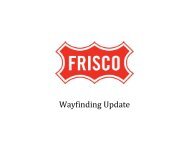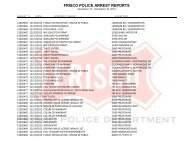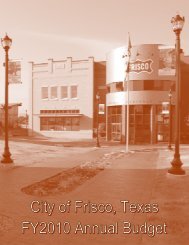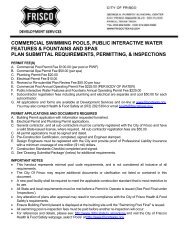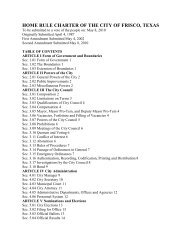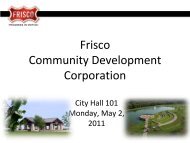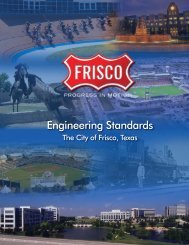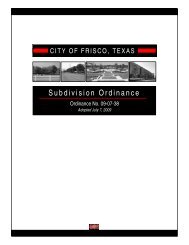No. 94-08-19 - City of Frisco
No. 94-08-19 - City of Frisco
No. 94-08-19 - City of Frisco
Create successful ePaper yourself
Turn your PDF publications into a flip-book with our unique Google optimized e-Paper software.
. Local Thoroughfares - (Type F, Local Street)<br />
Local residential streets shall have a minimum right-<strong>of</strong>-way width <strong>of</strong> fifty feet (50'), unless<br />
otherwise specifically permitted by the Planning and Zoning Commission and the <strong>City</strong><br />
Council. Local streets in apartment, commercial or industrial areas shall have a minimum<br />
right-<strong>of</strong>-way width <strong>of</strong> sixty feet (60').<br />
c. Secondary Thoroughfares - (Type E. Secondary Thoroughfare)<br />
Secondary or collector streets shall have a minimum right-<strong>of</strong>-way width <strong>of</strong> sixty feet (60').<br />
d. Major Thoroughfares - (Major Streets Types A B C, & D)<br />
The width <strong>of</strong> major streets shall be determined by the Planning and Zoning Commission,<br />
the <strong>City</strong> Council, the Major Thoroughfare Plan, and adopted standards. Major streets with<br />
a right-<strong>of</strong>-way width <strong>of</strong> less than one hundred feet (100') are to be increased to a width <strong>of</strong><br />
one-hundred feet (100') for a distance <strong>of</strong> two-hundred fifty feet (250') at the approach to a<br />
major street intersection, with a transition back to normal right-<strong>of</strong>-way width over a<br />
distance <strong>of</strong> an additional one-hundred fifty feet (150'). The typical width for Type A&B<br />
facilities is 120 feet <strong>of</strong> right-<strong>of</strong>-way. A typical Type C facility is 100 feet <strong>of</strong> right-<strong>of</strong>-way. A<br />
Type D facility is typically 65 to 80 feet <strong>of</strong> right-<strong>of</strong>-way.<br />
Streets within residential subdivisions larger than five (5) acres shall be laid out and platted<br />
so that a minimum <strong>of</strong> twenty-five percent (25%) <strong>of</strong> the total street length <strong>of</strong> all streets in<br />
the subdivision shall be designed in a curvilinear manner with a radius <strong>of</strong> 1,500 feet or less.<br />
Curvilinear streets shall be defined as those streets with a segment there<strong>of</strong> designed with a<br />
degree <strong>of</strong> curvature not less than 3 0 31' and not greater than 22°55'; and which shall <strong>of</strong>fset<br />
a minimum distance <strong>of</strong> thirty feet (30') said <strong>of</strong>fset being measured perpendicular to the<br />
initial tangent line <strong>of</strong> the curve. (Ordinance <strong>No</strong>. 98-06-07)<br />
8. Street Alignment<br />
The maximum deflection in alignment permitted without use <strong>of</strong> curve shall be ten degrees<br />
(10°).<br />
9. Major Street Curves<br />
Curves in major streets shall have a center line radius <strong>of</strong> 2,000 feet or more with exceptions to<br />
this standard granted only by the Planning and Zoning Commission and the <strong>City</strong> Council.<br />
10. Secondary Street Curves<br />
Curves in secondary or feeder streets shall have a center line radius <strong>of</strong> 800 feet or more, with<br />
exception to this standard granted only by the Planning and Zoning Commission andthe <strong>City</strong><br />
Council.<br />
11. Local Street Curves<br />
Curves in local streets are to have a center line radius <strong>of</strong> 300 feet or more, except for "loop" or<br />
partial "loop" streets.<br />
12. Reverse Curves<br />
Reverse curves on major thoroughfares and collector streets shall be separated by a minimum<br />
tangent <strong>of</strong> one hundred feet (100').<br />
7-2



